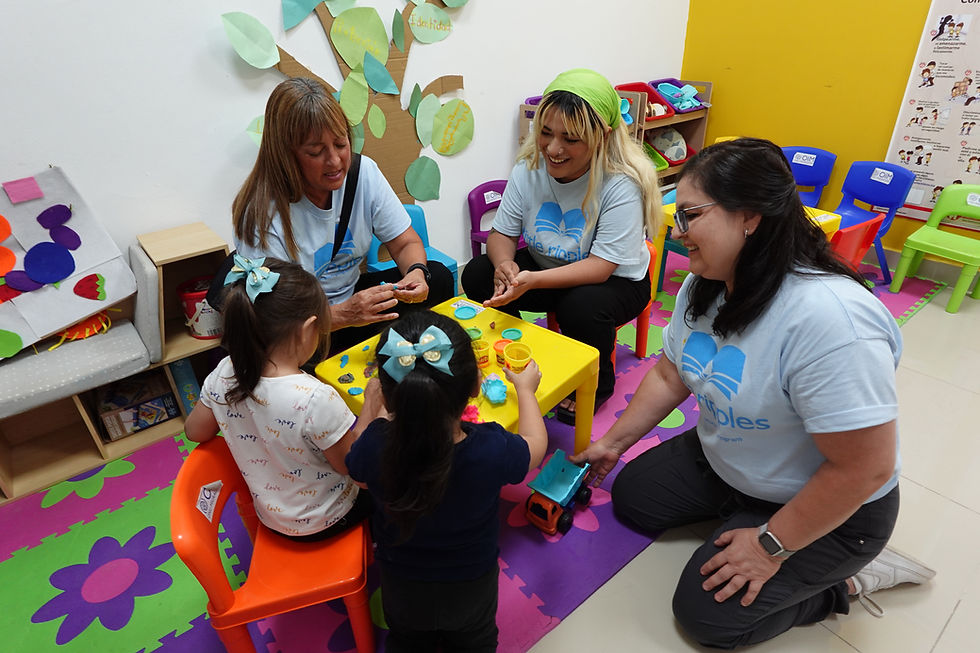An inside look at Little Ripples Teacher Training II with refugee women in eastern Chad
- Guest Post
- Oct 31, 2018
- 4 min read
Updated: Feb 19, 2024
“I hope we become leaders,” said Mouna during day three of Little Ripples Teacher Training II. Mouna is 21 years old and a Little Ripples teacher in refugee camp Kounoungou.
Leadership and teamwork became the overarching topics during our Little Ripples Teacher Training II. Two groups of women employed to lead our Little Ripples early childhood education program in two different refugee camps in eastern Chad came together this week for the first time to complete the second training. On day one, with the curriculum in hand, I jumped right into a Little Ripples welcome song, a brief “let’s get to know each other game,” and reviewed what they had learned during the first training back in February-March.
Three days later, my curriculum was full of notes and examples from the women for how they were adapting the curriculum to make it their own. It is clear they are knowledgeable, skilled, and passionate educators who are eager to become better program managers and leaders. The following content is an outline of the three-day Little Ripples Teacher Training II, including notes and examples from our training and images from our days together.
Training Day 1 and Day 2:
The pillars of Little Ripples: Peace, Helping, Sharing and examples of where the women see these pillars every day in their community. Sharing food with neighbors was the most common example during training.
Responsibilities of a teacher: Young children should feel safe and at peace, they should be having fun. If these first two are happening, then they will be learning. The teachers said the responsibility to make sure the children are “having fun” was something new for them.
Play-based learning: We talked about various ways to include directed play, free play, and outdoor play during the school day. During this topic, the teachers worked in small groups to come up with their own ideas for ways to teach children through play using Little Ripples educational materials. One group used colorful rings and a hopscotch game to teach colors and counting.
Positive behavior management and transformative language: The teachers were quick to remember the steps to positively care for and support children, but we spent a lot of time talking about why positive behavior and positive communication with young children was so impactful now and for the future of their community. During this topic, many of the women made the connection between early childhood and building a peaceful community.
Emotional literacy: Using our moon faces poster, we talked about feelings and emotions. This was not an easy topic for this group and it took time to distinguish between physical feelings and emotional feelings and why it’s important for young children to learn their emotions and the emotions of others.
Storytelling: We pulled out some books, read stories out loud, and talked about the impact of hearing and seeing stories for young learners. The women had some good laughs practicing reading a book out loud and engaging each other about each story.
Health and hygiene: The women reviewed the most basic, yet most impactful hygiene behaviors teachers can teach their students—stressing the use of latrines and handwashing with soap.
Training Day 3:
Mindfulness: After practicing some simple breathing exercises, the women were also introduced to Susan Kaiser Greenland’s mindfulness activities for young children and tried some simple walking and movement-based mindfulness.
Daily schedule: In small groups, the directors, teachers, and cooks created an outline of their daily schedule, making sure to include all the key moments of the day to create a safe and nurturing space for their students.
Monitoring and program management: What information would be most useful for you to know, as directors, teachers, and cooks of this program? was my question for the women. During this time, we talked about the overall importance of monitoring and why we do it, and the monitoring roles of the director, teacher, and cook. Then, together in groups with women who shared the same title, we reviewed their monitoring tools and came up with action plans for collecting and sharing information.
Weekly Meetings: We talked about the importance of these meetings as a time for the women to support each other, talk about problems, but more importantly, talk about solutions! We all agreed that there will always be challenges and it’s up to them, together, as a team to stay positive and find solutions. During training, challenges were presented, and several women had ideas for addressing each challenge. Some of the women had some “aha” moments during this session.
LEAD with EMPATHY: Following Training II, every woman receives an iACT LEAD with EMPATHY leadership and human rights curriculum. Together, directors, teachers, and cooks complete the curriculum during their weekly meeting. While reviewing the topics of the curriculum, the women talked about the prevalence of domestic violence against women and the inequalities they face in their community. They said they are eager to read the curriculum and learn about the human rights of women. When Mouna said, “I hope we become leaders,” I asked her how might they become leaders? She responded, “with more information and understanding.”


